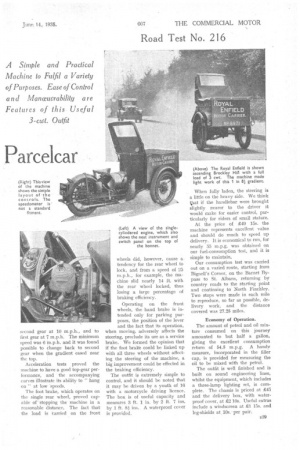50 Miles with The New Royal Enfield Parcelcar
Page 38

Page 39

If you've noticed an error in this article please click here to report it so we can fix it.
A Simple and Practical Machine to Fulfil a Variety of Purposes. Ease of Control and Manceuvrability are Features of this Useful 3-cwt. Outfit
STEADY development in the motorization of transport has been taking place . for many years, and suitable vehicles for all
• loads are now available. Until the advent of the Royal Enfield parcelcar, which is the subject of this • week's road test, there has, however, been a gap between the manually propelled tricycle for delivery work and the various 4-10-cwt. petroldriven three-wheeled machines.
That there is a wide field of application for a really lightweight machine, with a carrying capacity of 2-3 cwt., cannot be gainsaid, and its value is not confined only to replacing pedal transport. Such an outfit should prove useful to traders owning fleets of larger vehicles by acting as a tender to the bigger machines when their use for short delivery work, with but few packages, is uneconomic.
The new Royal Enfield is of neat and practical design, and a full de
scription of the machine appeared in the issue of The Commercial Motor dated May 10 last. Particulars will be found in the specification panel accompanying this article and the illustrations give a good idea of the layout of the outfit.
An Air-cooled Engine.
Powered by a 2f h.p. singlecylindered two-stroke petrol engine, the drive is transmitted by chain to a four-plate clutch and three-speed gearbox, thence by chain to the single rear wheel. Cooling is effected by a blower incorporated in the engine flywheel, and the ignition is by the coil system, the dynamo being
mounted transversely behind the engine and driven from it by a chain..
That the machine is amply powered was demonstrated on Cocks Hill, which has a gradient in the nature" of 1 in 6. On the steepest section, stop and restart tests were carried out, and every time the machine moved away with ease and certainty—this, of course, with a full load of 3 cwt.
The holding power of the brakes was also fully demonstrated on the descent of this hill, and both the hand and foot brakes proved capable of holding the machine on the severe gradient.
As a further test of the hill-climb.
ing capabilities of the machine, Brockley Hill, on the Edgware-St. Albans road, was tackled. This hill has a maximum gradient in the order of 1 in 81 and is approached by a long rise, the hill itself being about
mile long.
The Royal Enfield made light work of this acclivity. Approaching the steep section at about 20 m.p.h. on top gear, a change was made to
second gear at 10 m.p.h., and to first gear at 7 m.p.h. The minimum speed was 6 m.p.h. and it was found possible to change back to second gear when the gradient eased near the top.
Acceleration tests proved the machine to have a good top-gear performance, and the accompanying curves illustrate its ability to " hang on" at low speeds.
The foot brake, which operates on the single rear wheel, proved capable of stopping the machine in a reasonable distance. The fact that' the load is carried on the front wheels did, however, cause a• tendency for the rear wheel to lock, and from a speed of 25 m.p.h., for example, the machine slid nearly 14 ft. with the rear wheel locked, thus losing a large percentage of braking efficiency.
Operating on the front wheels, the hand brake is intended only for parking purposes, the position of the lever and the fact that its operation, when moving, adversely affects the steering, preclude its use as a service brake. We formed the opinion that if the foot brake could be linked up with all three wheels without affecting the steering of the machine, a big improvement could be effected in the braking efficiency.
The outfit is extremely simple to control, and it should be noted that it may be driven by a youth of 36 with a motorcycle driving licence. The box is of useful capacity and measures 3 ft. 1 in. by 2 ft. 7 ins. by 1 ft. 8 ins. A waterproof cover is provided.
When fully laden, the steering is a little on the heavy side. We think t,hat if the handlebar were brought slightly nearer to the driver it would make for easier control, particularly for riders of small stature.
At the price of £40 15s. the machine represents excellent value and should do much to speed up delivery. It is economical to run, for nearly 55 m.p.g. was obtained on our fuel-consumption test, and it is simple to maintain.
Our consumption test was carried out on a varied route, starting from Bignell's Corner, on the Barnet Bypass to St. Albans, returning by country roads to the starting point and continuing to North Finchley. Two stops were made in each mile to reproduce, so far as possible, delivery work, and the distance covered was 27.25 miles.
Economy of Operation.
The amount of petrol and oil mixture consumed on this journey amounted to but half a gallon, giving the excellent consumption return of 54.5 m.p.g. A handy measure, incorporated in the filler cap, is provided for measuring the oil to be mixed with the petrol.
The outfit is well finished and is built on sound engineering lines, whilst the equipment, which includes a three-lamp lighting set, is complete. The chassis is priced at £45 and the delivery box, with waterproof cover, at £2 10s. Useful extras include a windscreen at £1 15s. and leg-shields at 10s. per pair.




















































































